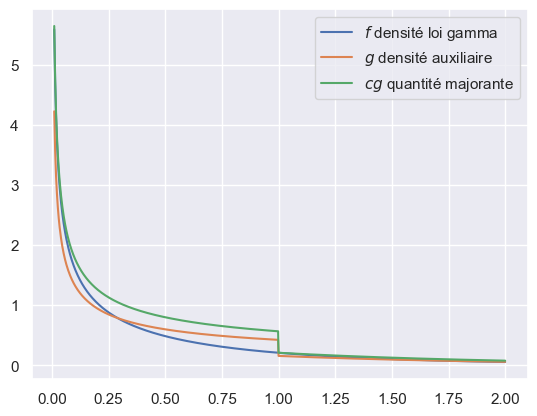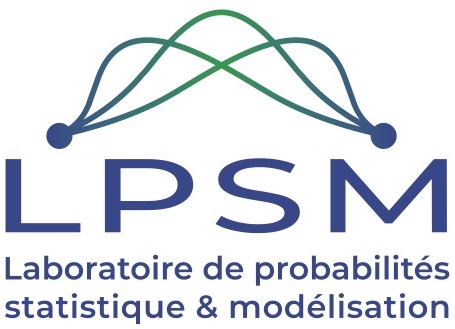1.6. Illustrations numériques autour de la méthode du rejet#
1.6.1. Exemple: loi gamma par la méthode du rejet#
Soit \(\alpha \in ]0, 1[\). On considère \(X\) de loi gamma de paramètre \(\alpha\) i.e. de densité
Pour mettre en oeuvre la méthode du rejet on considère par exemple la densité auxiliaire
qui vérifie \(f(x) \le \big(\frac{\alpha + e}{\alpha e \Gamma(\alpha)} \big) g(x)\) pour tout \(x \in \mathbf{R}\). Il est très important de considérer les fonctions \(f\) et \(g\) normalisées c’est à dire telles que \(\int f(x) \operatorname{d}\! x = \int g(x) \operatorname{d}\! x = 1\). La constante qui apparait dans l’hypothèse de majoration est donc ici \(c_\alpha = \frac{\alpha + e}{\alpha e \Gamma(\alpha)} > 1\).
Pour simuler selon la loi de densité \(g\) on utilise l’inverse de la fonction de répartition: on vérifie que la fonction quantile \(G^{-1}\) s’écrit
import numpy as np
import scipy.stats as stats
from scipy.special import gamma
import matplotlib.pyplot as plt
import seaborn as sns
sns.set_theme()
alpha = 0.5
rv = stats.gamma(alpha)
x = np.linspace(0.01, 2, 1000)
# toujours écrire une fonction vectorielle
# c'est à dire qui s'applique à un argument x de type `numpy.array`
# il faut donc éviter les tests `if x < 1 else ...`
def g(x, alpha):
cst = (alpha * np.exp(1)) / (alpha + np.exp(1))
result = np.empty_like(x)
result[x < 1] = x[x < 1]**(alpha-1)
result[x >= 1] = np.exp(-x[x >= 1])
return cst * result
# la constante c de l'hypothèse de domination
c = (alpha + np.exp(1)) / (alpha * np.exp(1) * gamma(alpha))
fig, ax = plt.subplots(1, 1)
ax.plot(x, rv.pdf(x), label=r'$f$ densité loi gamma')
ax.plot(x, g(x, alpha), label=r'$g$ densité auxiliaire')
ax.plot(x, c*g(x, alpha), label='$cg$ quantité majorante')
ax.legend()
<matplotlib.legend.Legend at 0x10cd83690>

